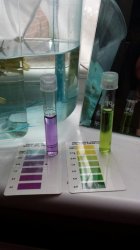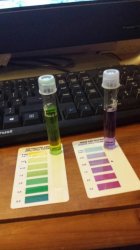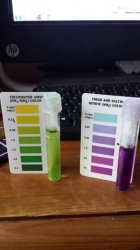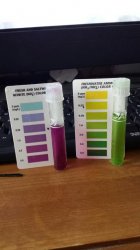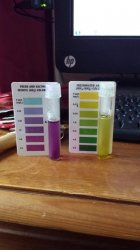You are using an out of date browser. It may not display this or other websites correctly.
You should upgrade or use an alternative browser.
You should upgrade or use an alternative browser.
My Seachem Stability Diary :)
- Thread starter annaw123
- Start date
The April FOTM Contest Poll is open!

🏆 Click to vote! 🏆
TwoTankAmin
Fish Connoisseur
Unless the tubes are held against the chart on the white area adjacent to the color bars you are wasting time posting your results as the displaying them as you have make them unusable. I suggest you read your test directions which explain this is the proper way to do this.
Imo, the best place to put Stability is in ones toilet. It does not contain any of the desired live autotrophic nitrifying bacteria. If you want to use a bacterial supplement look into Dr. Tim's One and Only.
Have your read the cycling article on this site yet?
Imo, the best place to put Stability is in ones toilet. It does not contain any of the desired live autotrophic nitrifying bacteria. If you want to use a bacterial supplement look into Dr. Tim's One and Only.
Have your read the cycling article on this site yet?
Ok.
Yes I have read the cycling article on the site, I have been keeping fish for over 5 years
Stability has helped myself, and several other members on this site successfully cycle their tanks ... you are entitled to your own opinion though
Yes I have read the cycling article on the site, I have been keeping fish for over 5 years
Stability has helped myself, and several other members on this site successfully cycle their tanks ... you are entitled to your own opinion though
annaw123-
From what I can see, your nitrite may have pegged the top of the chart. You should perform a dilution test to find out your actual nitrite level. Here's how I do it:
Take a clean cup, and fill the test tube with 5 mL of tank water, and then pour it into the cup. Then fill the test tube with 5 mL of distilled water, and pour that into the cup. Do that four times so that you have 1 part of tank water, and four parts of distilled water. Swirl the cup a little bit to mix it well, and then fill your 5 mL test tube from the cup. Perform your nitrite test as usual, and find the color on the chart. Then multiply your result by 5 to get the actual nitrite value (5:1 dilution). If your new test is still too high to read on the chart, then you may have to do a new test with 1 part tank water / 9 parts distilled water, and multiply the result by 10 (10:1 dilution).
I've found that even when my test result is still on the chart, those darker colors are difficult to discern, so I ended up doing the 5:1 test anyway when my nitrite was high.
From what I can see, your nitrite may have pegged the top of the chart. You should perform a dilution test to find out your actual nitrite level. Here's how I do it:
Take a clean cup, and fill the test tube with 5 mL of tank water, and then pour it into the cup. Then fill the test tube with 5 mL of distilled water, and pour that into the cup. Do that four times so that you have 1 part of tank water, and four parts of distilled water. Swirl the cup a little bit to mix it well, and then fill your 5 mL test tube from the cup. Perform your nitrite test as usual, and find the color on the chart. Then multiply your result by 5 to get the actual nitrite value (5:1 dilution). If your new test is still too high to read on the chart, then you may have to do a new test with 1 part tank water / 9 parts distilled water, and multiply the result by 10 (10:1 dilution).
I've found that even when my test result is still on the chart, those darker colors are difficult to discern, so I ended up doing the 5:1 test anyway when my nitrite was high.
TwoTankAmin
Fish Connoisseur
Gee whiz- my opinion huh. Five years huh? I only wish I knew as much as you or had your experience. Except you are here looking for help.
May I ask one question? If you know you should read and display results with the tube against the card, why did you not do so here in your pictures? This puzzles me. Since there are no fish in the tank which might be harmed, I will refrain from getting in your way.
I wish you good luck with your tank and hope you sort things out quickly.
btw- SeaChem hides the info on their site which states they know it is live autotrophic bacteria that handle nitrification because they also state Stability contains none of these. They also misidentify the exact bacteria, but they get the types right.
http /www.seachem.com/Library/SeaGrams/Biofiltration.pdf
/www.seachem.com/Library/SeaGrams/Biofiltration.pdf
If you would care to read the research papers which identified the exact strains you can find them here:
Nitrospira-Like Bacteria Associated with Nitrite Oxidation in Freshwater Aquaria
http /aem.asm.org/content/64/1/258.full
/aem.asm.org/content/64/1/258.full
Identification of Bacteria Responsible for Ammonia Oxidation in Freshwater Aquaria
http /aem.asm.org/content/67/12/5791.full
/aem.asm.org/content/67/12/5791.full
May I ask one question? If you know you should read and display results with the tube against the card, why did you not do so here in your pictures? This puzzles me. Since there are no fish in the tank which might be harmed, I will refrain from getting in your way.
I wish you good luck with your tank and hope you sort things out quickly.
btw- SeaChem hides the info on their site which states they know it is live autotrophic bacteria that handle nitrification because they also state Stability contains none of these. They also misidentify the exact bacteria, but they get the types right.
http
 /www.seachem.com/Library/SeaGrams/Biofiltration.pdf
/www.seachem.com/Library/SeaGrams/Biofiltration.pdfIf you would care to read the research papers which identified the exact strains you can find them here:
Nitrospira-Like Bacteria Associated with Nitrite Oxidation in Freshwater Aquaria
http
 /aem.asm.org/content/64/1/258.full
/aem.asm.org/content/64/1/258.fullIdentification of Bacteria Responsible for Ammonia Oxidation in Freshwater Aquaria
http
 /aem.asm.org/content/67/12/5791.full
/aem.asm.org/content/67/12/5791.fullFirstly, I wasn't saying I had 5 years experience as if that was a lot or meant I know what I am doing. I constantly seek to improve my knowledge and understanding of everything I do in life, including my keeping of fish. I said I had 5 years experience merely to demonstrate that I know the process of cycling very well ... which is quite clear from my reply I think.
Secondly I didn't claim to know about displaying or reading test results ... hence why I had displayed them incorrectly at first, then replied 'ok' in my reply to you after you had told me to display them correctly. After that, as you can see I have displayed my results correctly - so no need for you to be puzzled about that!
I didn't mean to cause any offence, but certainly received a bit of a hostile reply which is a little dissapointing ... thanks for the articles, I will be sure to give them a read. Hopefully our next encounter can be a little less sarcastic, as I certainly didn't mean to include any sarcastic tones in my first reply to you, and apologise if i did.
Thanks
Macphyter - Thanks for your help! I will be sure to do that test to find my actual nitrite level, that was super helpful
Secondly I didn't claim to know about displaying or reading test results ... hence why I had displayed them incorrectly at first, then replied 'ok' in my reply to you after you had told me to display them correctly. After that, as you can see I have displayed my results correctly - so no need for you to be puzzled about that!
I didn't mean to cause any offence, but certainly received a bit of a hostile reply which is a little dissapointing ... thanks for the articles, I will be sure to give them a read. Hopefully our next encounter can be a little less sarcastic, as I certainly didn't mean to include any sarcastic tones in my first reply to you, and apologise if i did.
Thanks
Macphyter - Thanks for your help! I will be sure to do that test to find my actual nitrite level, that was super helpful
TwoTankAmin
Fish Connoisseur
Annaaw- doing a diluted test it a great idea, doing the way it was explained is not such a good way. The reason is when working with mls, small amounts matter a lot. The best way to do diluted is as follows:
Get a measuring cup and fill it with 4 ounces of tank water, then add 4 ounces of distilled water. This results in a 50/50 dilution. From the cup fill your test tube to the 5 ml and do the test. Multiply any result not at the top of the scale by 2 to get your actual ppm. If the result is at the top of the chart you will do another dilution. Pour the remaining water from the measuring cup into a clean glass and then put back 4 ounces into the cup and add 2 more ounces of distilled water. You now have a 33% mix (2 oz tank and 4 of distilled). Use this to fill the tube (cleaned first) and test again. Multiply the result by 3 this time.
Since the level of nitrite, as tested on the scale used in the API test, at which nitrite will stall or kill the cycle is 16.4 ppm, I work with 15 ppm as the danger line to be safe. So if this test still comes at at the 5 ppm top level on the API kit, just do a 50% water change. Then retest normally, and then maybe you will have to retest a 50/50 mix. It is fine to have nitrite in the 10 ppm range, you just do not want to be near the 15 ppm line as any more nitrite created without the growth of the nitrite oxidizing bacteria can quickly push it too high again.
I am happy to help anyone with cycling and have managed to get a few folks on this site through problems so far. If I was a bit abrupt, it was because i just got out of the hospital after a bad fall and am a bit drugged and in a bit of pain. I did not mean to sound gruff in my initial post.
Get a measuring cup and fill it with 4 ounces of tank water, then add 4 ounces of distilled water. This results in a 50/50 dilution. From the cup fill your test tube to the 5 ml and do the test. Multiply any result not at the top of the scale by 2 to get your actual ppm. If the result is at the top of the chart you will do another dilution. Pour the remaining water from the measuring cup into a clean glass and then put back 4 ounces into the cup and add 2 more ounces of distilled water. You now have a 33% mix (2 oz tank and 4 of distilled). Use this to fill the tube (cleaned first) and test again. Multiply the result by 3 this time.
Since the level of nitrite, as tested on the scale used in the API test, at which nitrite will stall or kill the cycle is 16.4 ppm, I work with 15 ppm as the danger line to be safe. So if this test still comes at at the 5 ppm top level on the API kit, just do a 50% water change. Then retest normally, and then maybe you will have to retest a 50/50 mix. It is fine to have nitrite in the 10 ppm range, you just do not want to be near the 15 ppm line as any more nitrite created without the growth of the nitrite oxidizing bacteria can quickly push it too high again.
I am happy to help anyone with cycling and have managed to get a few folks on this site through problems so far. If I was a bit abrupt, it was because i just got out of the hospital after a bad fall and am a bit drugged and in a bit of pain. I did not mean to sound gruff in my initial post.
Ok great, I will do that diluted test tomorrow and post my results on here!  Thanks
Thanks 
Poor you, I work in a hospital in the oncology department and know that they can be very tiresome at times, I wish you a speedy recovery
Poor you, I work in a hospital in the oncology department and know that they can be very tiresome at times, I wish you a speedy recovery
Something is definitely happening, i think the nitrite is definitely a different colour 
Also, think I may have found the ammonia source ... one of my plants was dying but only the part under the gravel! So i couldn't see until today, the rest of it was still green! Not sure if that would make THAT much ammonia though!
Any help on what's going on in my fishless and non ammonia added cycle?
And more ammonia too it looks like?!
Also, think I may have found the ammonia source ... one of my plants was dying but only the part under the gravel! So i couldn't see until today, the rest of it was still green! Not sure if that would make THAT much ammonia though!
Any help on what's going on in my fishless and non ammonia added cycle?
And more ammonia too it looks like?!
Attachments
TwoTankAmin
Fish Connoisseur
I have no clue where the ammonia might be originating, but the readings sure indicate you have both it and nitrite. The nitrite on the first test was likely in the range of 6-8 ppm would be my guess.
I doubt one rotting plant in the gravel is causing the ammonia. I does look like your tap has some. Cleaning out the tank as you described would remove a bunch of potential ammonia sources. I would say dead spores and hatched bacteria that died from the Stability might v=be the cause, but that got cleaned and removed w/ water changes.
Ammonia detoxifiers will throw off results on an ammonia test but not on a nitrite test.
I would suggest you do not do any more water changes. They make if harder to know what is going on. The only concern is not allowing nitrite to rise above 15 ppm on the API kit. So when you hit the top of the scale, you need to keep doing the diluted testing. Unless you see nitrite at 15 or more or ammonia at 6.4 ppm (API test) or more, leave the water alone.
I doubt one rotting plant in the gravel is causing the ammonia. I does look like your tap has some. Cleaning out the tank as you described would remove a bunch of potential ammonia sources. I would say dead spores and hatched bacteria that died from the Stability might v=be the cause, but that got cleaned and removed w/ water changes.
Ammonia detoxifiers will throw off results on an ammonia test but not on a nitrite test.
I would suggest you do not do any more water changes. They make if harder to know what is going on. The only concern is not allowing nitrite to rise above 15 ppm on the API kit. So when you hit the top of the scale, you need to keep doing the diluted testing. Unless you see nitrite at 15 or more or ammonia at 6.4 ppm (API test) or more, leave the water alone.
Ok, wont do any more water changes and will do that dilution test if the nitrite gets higher again 
Luckily it turns out i'll be heading home next Sunday, so will grab some filter media from my big established tank!!
Luckily it turns out i'll be heading home next Sunday, so will grab some filter media from my big established tank!!
Latest Discussions
- Replies
- 1
- Views
- 50
- Replies
- 7
- Views
- 98

